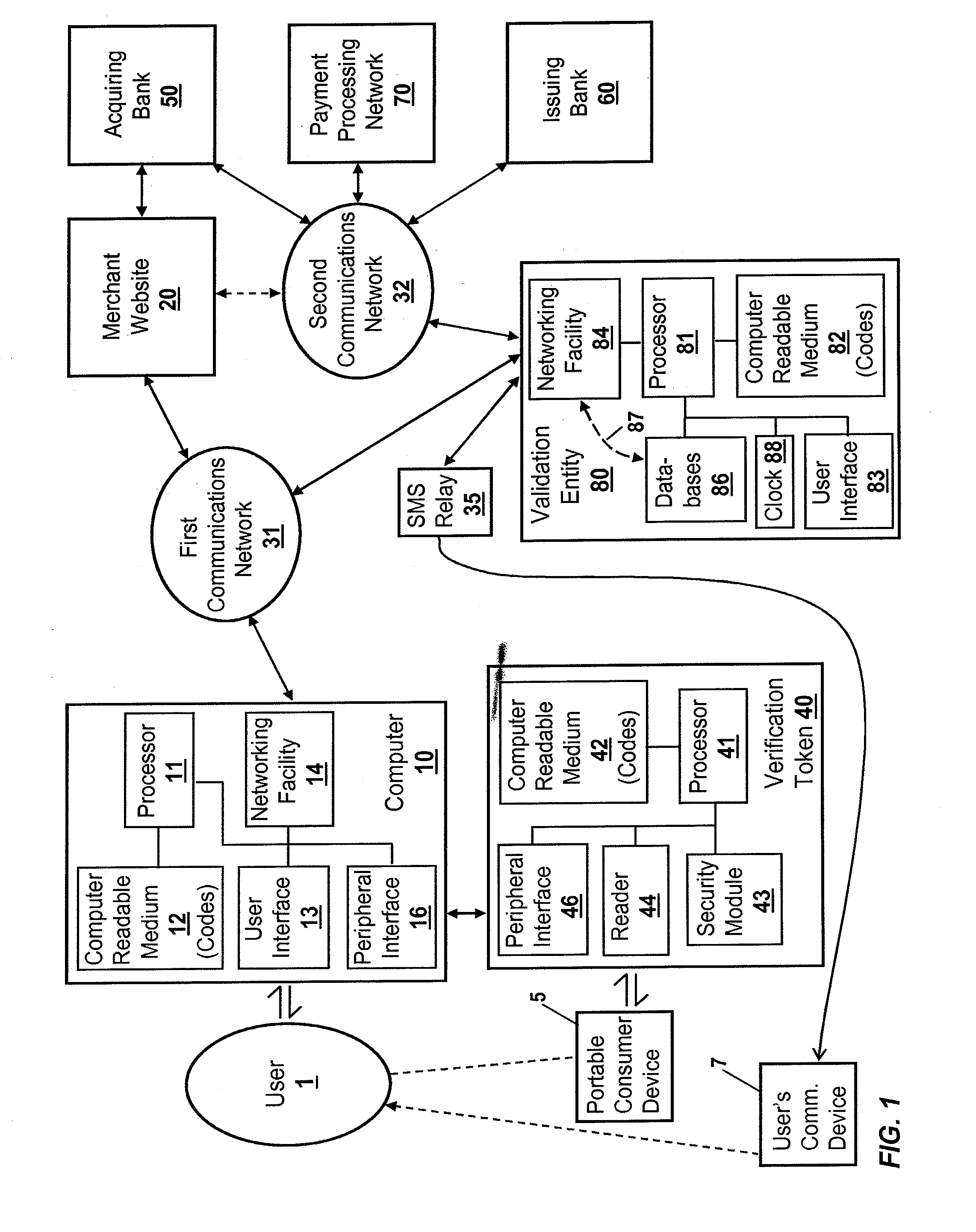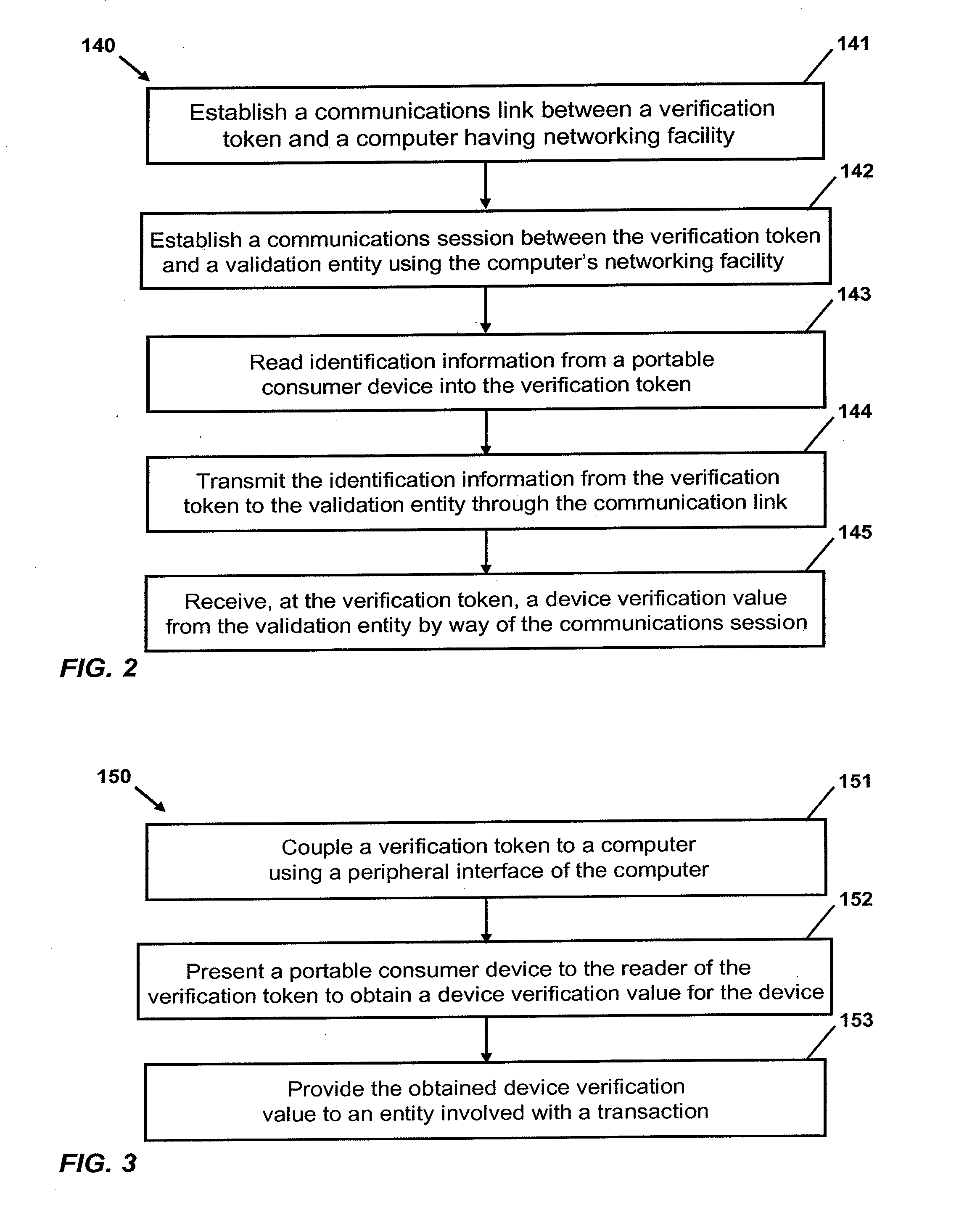Another exemplary embodiment of the invention is directed to a validation entity that provides device verification values to verification tokens. The exemplary validation entity comprises a computer-readable medium, a data processor electrically coupled to the computer-readable medium, and code embodied on the computer-readable medium that directs the data processor to perform various actions. The exemplary validation entity further comprises code that directs the data processor to communicate with a verification token over a communications network with a computer disposed between the verification token and the communications network, the verification token being coupled to the computer by way of a peripheral interface of the computer and configured to access a networking facility of the computer, the verification token being configured to read a portable consumer device for identification information, and to cause at least a portion of the identification information to be sent to the validation entity using the networking facility of the computer. The verification token also being configured to cause a serial number and an encrypted message to be sent to the validation entity using the networking facility of the computer. The message is encrypted by an encryption key, with the serial number and encryption key being uniquely assigned to the verification token. The exemplary validation entity further comprises code that directs the data processor to receive encrypted the serial number, the encrypted message, and identification information sent by the verification token, code that directs the data processor to apply at least one validation test to the serial number and encrypted message, and code that directs the data processor to transmit, if a selected number of the one or more validation tests are passed, a device verification value to the verification token. Further embodiments may include transmitting the device verification value to a payment processing network.
In each of the embodiments described above, and in each of the embodiments described below, the communications between the computer and the validation entity may be facilitated by, and / or conveyed through, a gateway (e.g., a proxy server, server entity, etc.) that is disposed between the computer and the validation entity. The gateway may act as an intermediary between a plurality of verification tokens and their associated computers on the one side, and a plurality of validation entities on the other side. The gateway may receive one or more initial communications from a verification token (via a computer in communication with the token), and may determine from information in the one or more initial communications an appropriate one of the validation entities to use to fulfill the token's request for a device verification value. For example, each verification token may be configured to operate with portable consumer devices issued by many different issuing banks or other such entities, and one or more of the validation entities may be configured to process requests from portable consumer devices issued by respective issuing banks or other such entities. The gateway may determine an appropriate one of validation entities to use based upon the identification information that the token read from a portable consumer device and sent to the gateway in an initial communication. In one implementation, the gateway redirects the token to the determined appropriate validation entity, with further communications occurring directly between the verification token and the appropriate validation entity. In another implementation, the communications between the verification token and the appropriate validation entity may be conveyed through the gateway (after the gateway has initially determined the identity of the appropriate validation entity based upon one or more initial communications with the token). This latter implementation may comprise relatively simple passing through of communications between the token and the appropriate validation entity with minimal processing by the gateway, or may comprise having the gateway virtually present itself as the appropriate validation entity to the verification token. Such virtual presentation may involve the gateway decrypting each message from the verification token, communicating with the appropriate validation entity to formulate a response to the token's message, and encrypting and sending a response message to the verification token. The gateway may also conduct one or more validation tests on behalf of the appropriate validation entity, particularly those related to validating the verification token. In this case, the gateway does not need to send to the appropriate validation entity those communications it receives from the token that pertain to validation tests that the gateway is handling. The gateway may be associated with, or operated by, a payment processing network.
Another exemplary embodiment of the invention is directed to a method of validating a portable consumer device presented to a verification token. The exemplary method comprises communicating with a verification token over a communications network with a computer disposed between the verification token and the communications network, the verification token being coupled to the computer by way of a peripheral interface of the computer and configured to access a networking facility of the computer. The verification token is configured to read a portable consumer device for identification information, and to send the identification information in encrypted form to the validation entity using the networking facility of the computer. The method further comprises decrypting identification information received from the verification token, and applying one or more validation tests to the decrypted identification information. The method further comprises transmitting, if a selected number of the one or more validation tests are passed, a device verification value to the token. Further embodiments may include transmitting the device verification value to a payment processing network.
Another exemplary embodiment of the invention is directed to a method of validating a portable consumer device presented to a verification token. The exemplary method comprises communicating with a verification token over a communications network with a computer disposed between the verification token and the communications network, the verification token being coupled to the computer by way of a peripheral interface of the computer and configured to access a networking facility of the computer. The verification token is configured to read a portable consumer device for identification information, and to send the identification information to the validation entity using the networking facility of the computer. The verification token is also configured to send a serial number and a message encrypted by an encryption key to the validation entity, with the serial number and encryption key being uniquely assigned to the verification token. The method further comprises receiving the serial number, encrypted message, and identification information from the verification token, and applying one or more validation tests to the serial number and encrypted message. The method further comprises transmitting, if a selected number of the one or more validation tests are passed, a device verification value to the token. Further embodiments may include transmitting the device verification value to a payment processing network.
 Login to View More
Login to View More  Login to View More
Login to View More 


